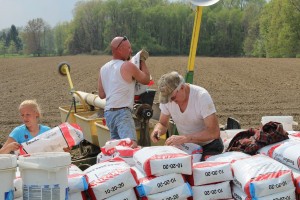SALEM, Ohio — Depending on which side of the road you live, or in which county, your corn may already be sprouting, or it may still be in the bag.
Scattered rain showers the past week wreaked havoc on some farmers’ planting progress, while others, who missed the rains, are done planting corn and have moved on to beans, or are ready to make hay.
Tom Pugh, a certified crop adviser with Agland Co-op, said some places saw a half-inch of rain the morning of May 11, while nearby places were dry and the planters were still rolling.
Overall, he said the past week seemed good for area farmers — who rushed to the fields not only because it was dry, but because the temperature was unseasonably warm in the mid- to upper 80s.
“This year, we have planters running everywhere at the same time,” said Pugh, who noted that it’s been a challenge for custom applicators to keep up.
Unusual pattern
Most years, planting begins in the southern Ohio counties and gradually progresses to the north, but this year, “it (planting) just broke everywhere,” he said.
Farmers in western Pennsylvania are well ahead with their planting, as well. A cold spell in late April had some farmers worried planting would be late, but many Pennsylvania farmers are actually ahead of their projections.
“A couple weeks ago, I thought it would be until June before we started planting,” said Matt Chalupka, a Mercer County grain farmer.
He was just getting started on the nearby John Murcko farm, but had already planted about 165 acres of corn on his own farm.
By the numbers
According to the National Agricultural Statistics Service, 55 percent of Ohio corn was planted as of the week ending May 10, compared to 15 percent last week, and the five-year average of 47 percent.

In Pennsylvania, 44 percent of corn was planted as of May 10, compared to 7 percent last week, and the five-year average of 37 percent.
Oats in Pennsylvania are 79 percent planted. The downside to all the early progress is that market prices are still low. Corn is selling for less than $3.50 a bushel, and soybeans are barely reaching $9.
“It’s terrible,” Murcko said. “That’s the way they (prices) were 40 years ago.”
At the beginning of May, researchers were warning farmers against the damage from going into wet fields too soon. In some places where the rains have persisted, that’s probably still good advice.
“Yield reductions from mudding in the corn can be more costly than delayed planting,” said Peter Thomison, an OSU Extension agronomist, in a released statement. “If the conditions aren’t right, growers don’t need to rush in and mud their corn just for the sake of planting early.
“Some years we’ve had growers who’ve reported outstanding yields on corn that wasn’t planted until late May.”
Optimal planting
Historically, the optimal time to get corn planted in southern Ohio is between April 10 and May 10, and in northern Ohio, between April 15 and May 10, according to Extension. But the optimum time all depends on weather and soil conditions, as Thomison notes.
Overall, May will continue to be warmer and drier than normal across Ohio, according to Jim Noel, an Ohio-based hydrologist with the National Weather Service. The best chances for normal rainfall appear to be across northern Ohio, he predicted, in the latest edition of OSU’s CORN Newsletter.
The summer looks to see significant swings in above- and below-normal temperature bursts, according to Noel, with swings of wet and dry periods that may average out — but still provide significant periods of stress to crops.
Other crops
While the warm month has farmers busy planting, it’s also causing a lot of growth in pastures and in forage crops.
Pugh said he’s telling the farmers he advises to get ready to cut hay, because it’s either ready, or just days away.
The heat is also leading to early issues with alfalfa weevil, according to Andy Michel, an entomologist based at the OARDC in Wooster. He recommends farmers keep up with their alfalfa scouting, and make any treatments or early harvests based on the results.
The detection of one or more large larvae per stem on alfalfa that is 12 inches or less in height indicates a need for rescue treatment, he said.
Where alfalfa is between 12 and 16 inches in height, the action threshold should be increased to two to four larvae per stem, depending on the vigor of alfalfa growth. When alfalfa is 16 inches in height and there are more than four larvae per stem, early harvest is recommended.












